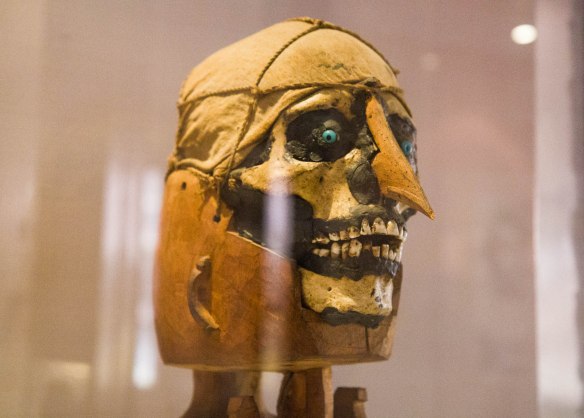I just read an article in Tempo, Indonesia’s major English-language political magazine, about the neglect most museums in the archipelago suffer from.
This is perhaps true, but I was more impressed than I expected to be with Jakarta’s National Museum, a considerably more polished affair than the mothballed and distinctly chloroform-scented halls of other Asian museums I’ve visited.
It’s not exactly the Smithsonian Natural History Museum — although that old US stalwart is also showing signs of age and wear — but what with the remains of Java Man, many and sundry monumental structures culled from all over the nation, and an interesting ethnography section, it’s worth a few hours wander. Another plus: there’s air conditioning.

I’m in the beginning stages of familiarizing myself with Indonesian history and culture, but I’m enjoying tracking the influence of Hindu and Buddhist art styles and schools of thought here — similar in some interesting ways to the Khmer and Thai art I’m more accustomed to thanks to my time in Phnom Penh, and wandering around Angkor Wat on a fairly regular basis. Borabodur is next on the agenda.
Although the sculptures are not labeled — a serious omission — the experience of wandering around looking at them is something of an art history textbook made flesh, which does have a certain appeal. They get damp when it rains and collect moisture, which may not be good for the artwork but has a certain aesthetic appeal.
 I like Papuan art because it is savage — yes, I used that adjective — and has a bizarre, irreverent feeling, that doubtless scandalized legions of Texan missionaries and likely still continues to do so in some remote pockets. Papuan art merrily portrays gigantic elongated penises, breasts, and violence, and is also quite content to incorporate the remains of venerated ancestors into powerful sculptures.
I like Papuan art because it is savage — yes, I used that adjective — and has a bizarre, irreverent feeling, that doubtless scandalized legions of Texan missionaries and likely still continues to do so in some remote pockets. Papuan art merrily portrays gigantic elongated penises, breasts, and violence, and is also quite content to incorporate the remains of venerated ancestors into powerful sculptures.
The statue is meant to serve as a mediator between the earth-bound family of the deceased and the spirit world, and can bring rain and good fishing if treated nicely, among other boons. You can’t see them in this photo, but the statue has carved wooden arms and legs, the skull meant to symbolize the head.
I have threatened to do this to my family. They all seem curiously fine with the idea, which makes me think I could start a new millenial trend for disposing of one’s venerated ancestors. I guess I could pray to them for more Twitter followers.
A lovely Papuan urn meant to resemble the head of a cassowary, those enormous and occasionally homocidal birds that still stalk bits of Papua and Papua New Guinea. I am absolutely terrified of them.
I recall this is Balinese, but can’t find any information on the Internet about it, which indicates I should do a better job of photographing labels. In any case, I think she’s excellently weird.
Here’s another Papuan ancestor statue, which is impressionistic and something I can see perched on the mantelpiece of a sensitive oligarch. Maybe I should do this for my ancestors instead of the skull thing.
 Ladies taking measurements of things. The museum was distinctly quiet on a Saturday afternoon, but there were some scattered tourists. Perhaps more people need to come.
Ladies taking measurements of things. The museum was distinctly quiet on a Saturday afternoon, but there were some scattered tourists. Perhaps more people need to come.




